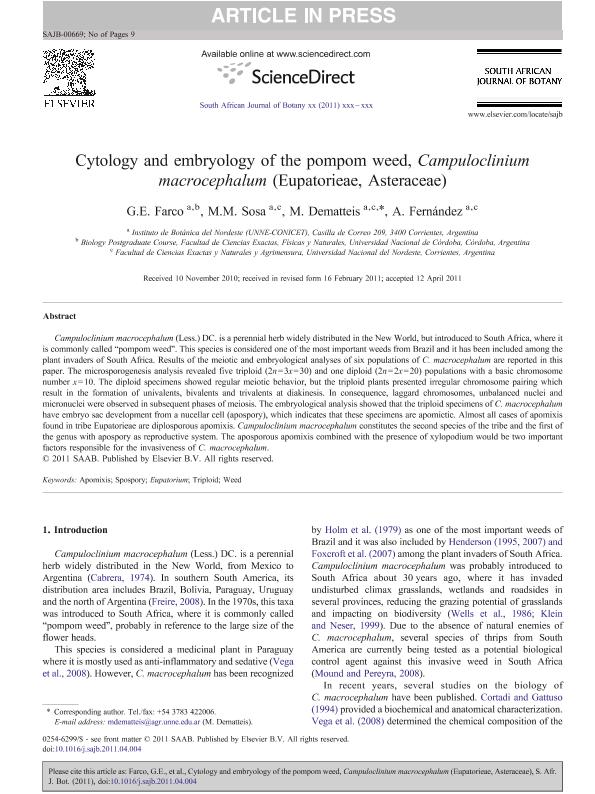Mostrar el registro sencillo del ítem
dc.contributor.author
Farco, Gabriela Elizabeth

dc.contributor.author
Sosa, Maria de Las Mercedes

dc.contributor.author
Dematteis, Massimiliano

dc.contributor.author
Fernandez, Aveliano
dc.date.available
2015-11-17T17:58:14Z
dc.date.issued
2012-01
dc.identifier.citation
Farco, Gabriela Elizabeth; Sosa, Maria de Las Mercedes; Dematteis, Massimiliano; Fernandez, Aveliano; Cytology and embryology of the pompom weed, Campuloclinium macrocephalum (Eupatorieae, Asteraceae); Elsevier Science; South African Journal Of Botany; 78; 1-2012; 21-29
dc.identifier.issn
0254-6299
dc.identifier.uri
http://hdl.handle.net/11336/2842
dc.description.abstract
Campuloclinium macrocephalum (Less.) DC. is a perennial herb widely distributed in the New World, but introduced to South Africa, where it is commonly called “pompom weed”. This species is considered one of the most important weeds from Brazil and it has been included among the plant invaders of South Africa. Results of the meiotic and embryological analyses of six populations of C. macrocephalum are reported in this paper. The microsporogenesis analysis revealed five triploid (2n= 3x= 30) and one diploid (2n= 2x= 20) populations with a basic chromosome number x= 10. The diploid specimens showed regular meiotic behavior, but the triploid plants presented irregular chromosome pairing which result in the formation of univalents, bivalents and trivalents at diakinesis. In consequence, laggard chromosomes, unbalanced nuclei and micronuclei were observed in subsequent phases of meiosis. The embryological analysis showed that the triploid specimens of C. macrocephalum have embryo sac development from a nucellar cell (apospory), which indicates that these specimens are apomictic. Almost all cases of apomixis found in tribe Eupatorieae are diplosporous apomixis. Campuloclinium macrocephalum constitutes the second species of the tribe and the first of the genus with apospory as reproductive system. The aposporous apomixis combined with the presence of xylopodium would be two important factors responsible for the invasiveness of C. macrocephalum. © 2011 SAAB. Published by Elsevier B.V. All rights reserved.
dc.format
application/pdf
dc.language.iso
eng
dc.publisher
Elsevier Science

dc.rights
info:eu-repo/semantics/openAccess
dc.rights.uri
https://creativecommons.org/licenses/by-nc-sa/2.5/ar/
dc.subject
Apomixis
dc.subject
Spospory
dc.subject
Eupatorium
dc.subject
Triploid
dc.subject
Weed
dc.subject.classification
Ciencias de las Plantas, Botánica

dc.subject.classification
Ciencias Biológicas

dc.subject.classification
CIENCIAS NATURALES Y EXACTAS

dc.title
Cytology and embryology of the pompom weed, Campuloclinium macrocephalum (Eupatorieae, Asteraceae)
dc.type
info:eu-repo/semantics/article
dc.type
info:ar-repo/semantics/artículo
dc.type
info:eu-repo/semantics/publishedVersion
dc.date.updated
2016-03-30 10:35:44.97925-03
dc.journal.volume
78
dc.journal.pagination
21-29
dc.journal.pais
Países Bajos

dc.journal.ciudad
Londres
dc.description.fil
Fil: Farco, Gabriela Elizabeth. Consejo Nacional de Investigaciones Científicas y Técnicas. Centro Científico Tecnológico Nordeste. Instituto de Botánica del Nordeste (i); Argentina. Universidad Nacional de Cordoba. Facultad de Ciencias Exactas, Fisicas y Naturales; Argentina
dc.description.fil
Fil: Sosa, Maria de Las Mercedes. Consejo Nacional de Investigaciones Científicas y Técnicas. Centro Científico Tecnológico Nordeste. Instituto de Botánica del Nordeste (i); Argentina. Universidad Nacional del Nordeste. Facultad de Ciencias Exactas Naturales y Agrimensura; Argentina
dc.description.fil
Fil: Dematteis, Massimiliano. Consejo Nacional de Investigaciones Científicas y Técnicas. Centro Científico Tecnológico Nordeste. Instituto de Botánica del Nordeste (i); Argentina. Universidad Nacional del Nordeste. Facultad de Ciencias Exactas Naturales y Agrimensura; Argentina
dc.description.fil
Fil: Fernandez, Aveliano. Consejo Nacional de Investigaciones Científicas y Técnicas. Centro Científico Tecnológico Nordeste. Instituto de Botánica del Nordeste (i); Argentina. Universidad Nacional del Nordeste. Facultad de Ciencias Exactas Naturales y Agrimensura; Argentina
dc.journal.title
South African Journal Of Botany

dc.relation.alternativeid
info:eu-repo/semantics/altIdentifier/doi/http://dx.doi.org/10.1016/j.sajb.2011.04.004
dc.relation.alternativeid
info:eu-repo/semantics/altIdentifier/url/http://www.sciencedirect.com/science/article/pii/S0254629911000536
Archivos asociados
